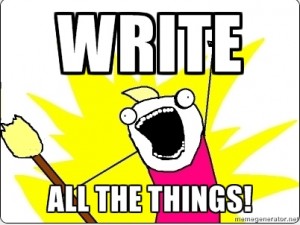 One of the things that Chuck Wendig’s brilliant post In Which I Critique Your Story (that I haven’t read) points out–in a hilarious yet gentle way–is that writing teachers see beginning authors making the same mistakes over and over. He covers a lot of those basic errors within the post. Memorize every word.
One of the things that Chuck Wendig’s brilliant post In Which I Critique Your Story (that I haven’t read) points out–in a hilarious yet gentle way–is that writing teachers see beginning authors making the same mistakes over and over. He covers a lot of those basic errors within the post. Memorize every word.
When I teach novel writing at the more advanced level for the UCLA Writers’ Extension Program, I get to see the next generation of mistakes… the things writers do after they’ve learned the lessons of Chuck. In Mysterious Informants, I’ve talked about some of the dynamics that arise when you have one in-the-know character teasing your protagonist and the reader, while failing to reveal any useful plot clues. Now I want to talk about a different kind of informational exchange: it’s a scene where one character is telling others about something that the reader has already witnessed, in an on-stage, pie-in-your-face, OMG watch out for the clown-car, Noooooo!!! unforgettable kind of scene.
Whatever it was, it mattered to the characters… obviously, or they wouldn’t be updating the people who were home, tucked into bed, during the clown car collision. But what I see in newer novelists tackling this transaction is this: a faithful and complete summary of something we vividly remember.
And that’s boring.
What can you do? These other characters do have to be brought up to speed, right? Tommy can’t freak out over Chris cheating on him until Pat mentions having seen the two of them playing tongue-lacrosse in the sauna, am I right? Plus, the reader needs to see how Tommy reacts. Maybe the next thing that happens in the story depends on that reaction!
The difficulty lies not in the transmission of the narrative of the clown car collision. It’s the faithful and full disclosure that’s problematic. That’s what reduces us to feeling as though we are binge watching something like Buffy the Vampire Slayer, and we’ve hit the Previously On section. Previously On is a useful refresher when you’re watching the show one hour at a time, at one-week intervals. But hey–if you just saw all this same stuff five minutes ago, all it’s good for is a bathroom break.
So. Techniques:
1. Summarize: We have the bearer of the news, and the audience. If the bearer really is going to tell the listener everything, try giving them one opening line. “Maybe you’d better sit down,” is a classic. Then just wrap it up: “I told her about Frankie’s meltdown the day before, working hard to remember every detail.”
2. Give them a reason to leave out a crucial bit: Why do they provide every detail? As yourself: who is this person, and might they have a reason to omit something? “He outlined what happened, telling her everything except the part about how he squeezed the mustard bottle so hard that they all went home covered in yellow stains. ”
3. Think of witness bias: does your gossip, the bearer of the tale, actually see what happened in the same terms as the other characters involved? Events worth spending not one but at least two scenes on better be a little intriguing. They’re hopefully dramatic, and preferably they’re life altering. If you put ten people in a room and show them life-altering, is there any chance their stories are going to line up perfectly? If Joy kills someone in self-defense in chapter two, how much more interesting is it if chapter three opens with, “Are you kidding? It was cold-blooded, premeditated murder,” Mallory declared.
4. Can they fight? Which brings us to: how many tellers are there, and are they in complete agreement about what happened? “Holy shit, Emily, Bobo the Clown totally swerved on purpose to hit us! Stop apologizing for him?”
What if they exaggerate? What if they lie?
5. Is the news-bearer clueless? What if your reporter saw the whole thing and had no idea why it was important? “Yuck yuck yuck, we saw Elizabeth nailing some dude, in the steam room, didn’t see his face… hey, buddy, you okay? You’re lookin’ kinda furtive all of a sudden. So, as I was saying…”
6. Why is this message getting passed along at all? Review the reasons why you’ve got this briefing onstage. Fictional characters are just as happy as we are to text the boring bits to their friends and loved ones. Is the bearer motivated by good will, the desire to gossip, or the need for solace or support? Have they been asked to spread the word? Are they hoping that speaking up will make them look good? Are they after revenge?
7. Does the recipient want to hear it? What if they’ve got their fingers in their ears and are screaming “La La La Get Out!!”
By now you can see the point I’m making: unless there is some kind of twist on the second telling of your clown car massacre, there’s no point in taking us all through it again.
Remember before you go into the scene that the thing we already know isn’t important. You are writing this passage because the character reactions matter, because someone is going to give inaccurate or incomplete or just-plain-wrong information, because new light is going to be shed on the events or characters involved, or because this conversation is going to trigger the next round of important character and plot developments.
Figure out what the important thing is. Craft the scene so the crucial bit is the one that receives the emphasis.
______________
*My Writing102 tag is a 2015 addition to this site – it’s meant to indicate essays for writers who aren’t entirely inexperienced. The Internet has a wealth of information for people just starting out, and less for those looking to develop next-level skills. In these essays, I’m trying to explore questions that might challenge people who can already write coherent, readable prose and have some idea how a story may be structured–people trying to get to the next level.
I welcome your feedback, as well as other suggestions for similar articles.




